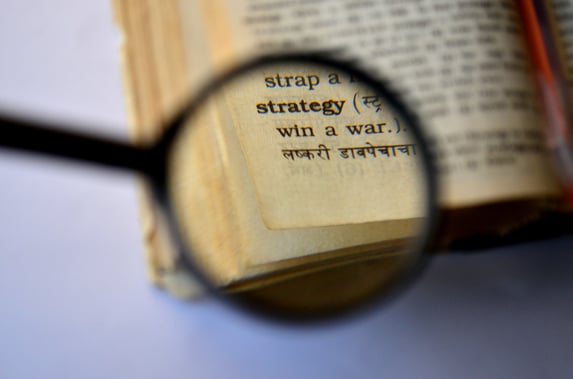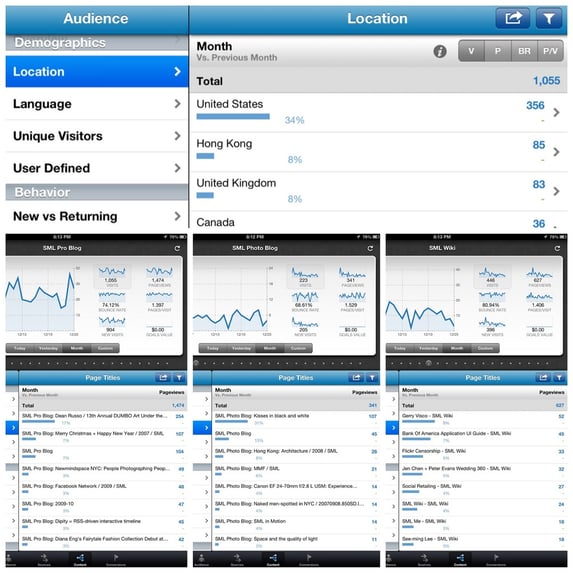Click Through Rate (CTR) - Click through rate tells you how many people actually clicked on your link, CTA, ad, or post out of the total number of impressions.
You can calculate your CTR by dividing the number of clicks by the number of times the link was viewed or served. (1 click / 100 views = .01 (1%) CTR)
Marketers use CTR to evaluate how well the link/CTA/ad/whatever was targeted. A high CTR means it was viewed by people who were interested in the link. A low CTR indicates the targeting conditions should be reevaluated, since the people who saw it weren't interested.
Content - Any text-based, visual, audio, or interactive media an Internet user will encounter (in this context, we'll only be talking about online content).
This includes writing of all kinds, images, videos, music, games, surveys - really, "content" can be anything your heart desires.
So, when marketers talk about the "content" you put online (or something like "populating your blog with content"), it's not limited to just writing.
Content Management System (CMS) - A CMS is a computer application that allows you to quickly and easily manage all of the content on your website.
CMS aren't just for marketers - many business owners and bloggers love them because they can create, edit, and post their own content without going through a webmaster.
CMS can be either a free or paid service.
Major CMS include WordPress (below) and HubSpot.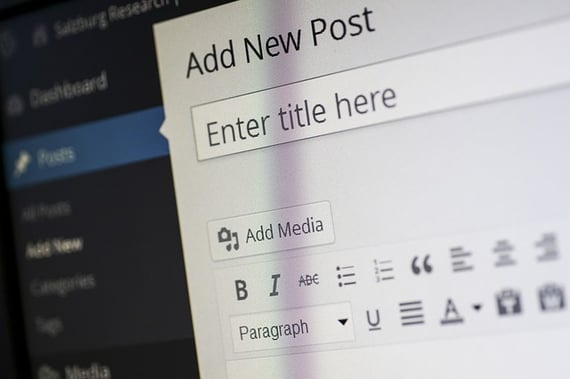
Content Marketing - An inbound marketing tactic.
Inbound marketing and content marketing are NOT the same thing. Content marketing is only one component of a good inbound marketing strategy.
Content marketing is defined by CMI as a strategic marketing approach focused on creating and distributing valuable, relevant, and consistent content to attract and retain a clearly-defined audience -- and, ultimately, to drive profitable customer action.
Sounds a lot like inbound marketing, right? Well, the main difference is content marketing works alongside - but doesn't include - SEO, PPC, and any other non-content focused inbound tactics.
Conversions - When a website visitor turns into a lead or customer.
Visitors can convert to leads by exchanging their contact information for a valuable piece of content or other offer.
Visitors and leads convert to sales only after they make a purchase.
Conversion Rate - Similar to click through rate, the conversion rate tells you how many people converted out of the total number of visitors to your site.
Conversion rate is calculated by dividing the number of conversions by the total number of visitors. (1 conversion / 100 visitors = .01 (1%) conversion rate)
Calculating your conversion rate can help you understand how effective your targeting methods are. If you only get one conversion from ten thousand website visitors, you'll probably want to make changes to your marketing strategy.
The average overall website conversion rate is only 2%. This average will vary slightly by industry.
Copy - Written content; text.
Customer Relationship Management System (CRM) - Similar to a CMS, a CRM system is a computer application that allows you to manage customer accounts, email marketing, customer relations, and more from a central software location.
CRM systems can be free or paid. The most popular CRMs include SalesForce, Oracle, and Insightly.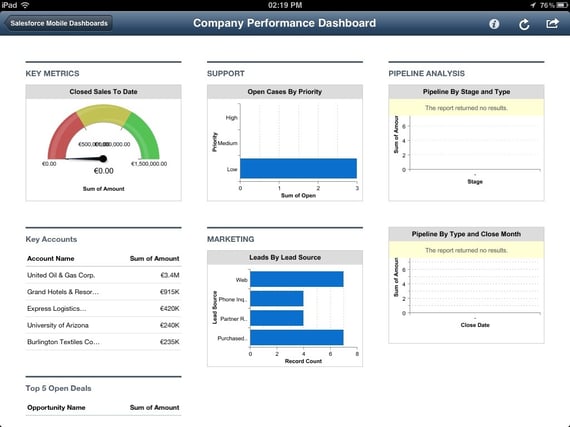
E
Ecommerce - Buying and selling goods or services online.
Ecommerce websites will have the familiar product listings, shopping cards, and transaction forms available entirely online.
Major ecommerce sites include Amazon and eBay, but these sites can be as small and specific as a handmade alpaca-fur hat store.
Email Blast - An email sent to many recipients. May or may not be targeted, though inbound marketing encourages targeting as much as possible.
Email Marketing - An inbound marketing tactic.
Email marketing describes the act of directly marketing to potential or existing customers using email messaging.
When marketers talk about email marketing, they could be thinking as broadly as the marketing automation software and all of your email campaigns, or as specifically as one commercial email blast.
F
Form - A series of fields a website visitor can fill out with information.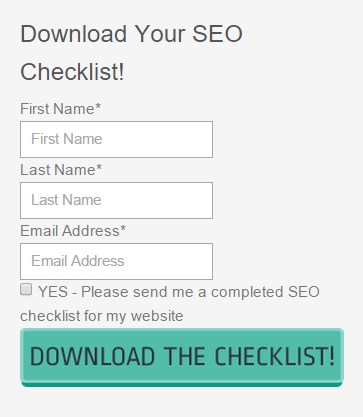
Marketers use forms to capture contact information, allowing them to make contact with leads and track them in their CRM.
Funnel (Marketing, Sales) - Similar to the buyer's journey, the marketing and sales funnels refer to the journey a buyer takes leading up to either a sale.
The funnel looks like this: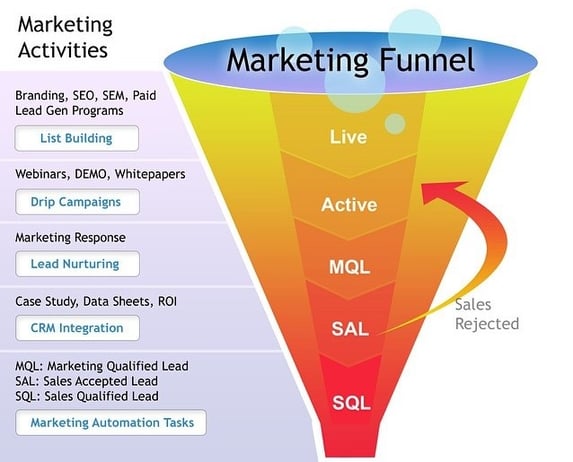
The main difference is that the funnel is a resource for marketers and salespeople to qualify the status of the lead and discuss strategy with other marketers.
The buyer's journey is more of a benefit for the buyers themselves. It guides marketers in their content creation process to offer valuable and useful information at every stage of the buyer's journey.
G
Gated Content - Content that's hidden behind a form. Your visitors have to fill out the form to access the content.
Gated content is generally much more valuable (or longer) than non-gated content.
I
Impressions - Views of an ad, link, post, or media.
Impressions refer ONLY to passive views, not active clicks or other interactions.
Inbound Links (Link Building) - An inbound marketing tactic.
Refers to instances of an outside site linking back to your website.
Building inbound links makes your inbound marketing strategy super effective. Google and other search engines like to see inbound links, since they suggest the linked page is high-quality.
Inbound links are difficult to build since they rely on another person adding the link to their website, which you can't really control.
We do not recommend buying inbound links - Google is good at sniffing out those shenanigans.
K
Keywords - An inbound marketing tactic.
Keywords are phrases or words that are relevant to your business/industry/products/etc., and that Internet users will type into search engines to find you.
Short-tail keywords: 1-2 keywords. Targets a broad audience. Harder to rank for in search, and more expensive in PPC campaigns.
Example: wall paint, used cars
Long-tail keywords: 3+ keywords. Targets a specific audience. Easier to rank for in search, and less expensive in PPC campaigns.
Example: best wall paint for bathrooms, used environmentally friendly cars
L
Landing Page - An inbound marketing tactic.
A landing page generally has a form and exists only to capture a visitor's info on that form.
Landing pages are visually similar to the rest of your website, but without distractions such as a sidebar or navigation.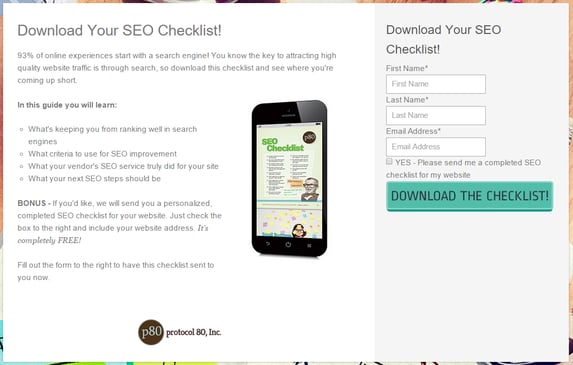
Lead - A potential buyer who has given you their contact information and is very likely to become a customer.
The term "lead" refers to ANY contact information you receive, but those leads will fall on a spectrum of quality - anywhere from "just wanted to download this eBook" to "loves your product and wants to buy it right now."
Lead scoring will tell you which leads are which.
Lead Generation - Turning your website visitors into leads; generating enough interest in your product/brand to make a visitor exchange their contact information for more information on your product/brand.
You can improve your lead generation by:
- Using buyer personas and the buyer's journey to more carefully target your best buyers
- Creating a clear path through your site with CTAs and landing pages
- Focusing on creating content that is valuable and relevant to the visitor instead of selling your product/brand
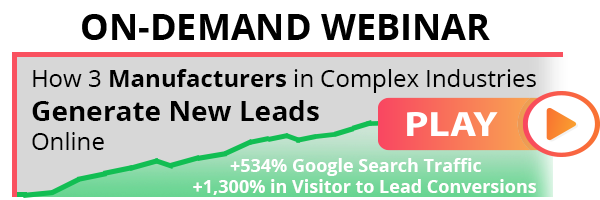
Lead Nurturing - An inbound marketing tactic.
Lead nurturing nudges a lead along their buyer's journey, down the marketing funnel, and towards a sale.
You remind the buyer that you exist, you have something they might want, and that they should consider what you have to offer before taking the next step. You build a relationship with the lead, making them more likely to think of you when it's time to purchase.
Lead nurturing can be done with email marketing, personalized CTAs, and targeted content offers.
Lead Scoring - When marketers and salespeople qualify leads based on their value as potential customers, and how likely they are to make a sale.
Lead scoring sifts out low-quality leads and creates a smooth transition from marketing to sales when they hand off a high-quality lead.
Lead scoring is a valuable practice - it ensures you're not spending your time and resources on dead end leads.
Lead scoring is also very important in marketing automation.
M
Marketing Automation - An inbound marketing tactic.
Marketing automation software allows you to automatically track leads, serve CTAs, send out personalized messages based on the actions a visitor takes on your website, and more.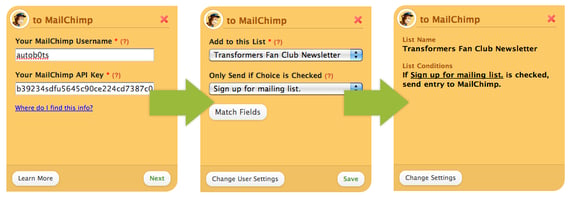
Marketing automation is great for businesses of all sizes. It automates all the busywork, allowing you to focus on growing your business.
Marketing automation is a very helpful aspect of email marketing, social media, and lead nurturing.
Marketing Qualified Lead (MQL) - A marketing qualified lead has indicated that they are very likely to make a purchase; a "genuine lead."
If your business has separate marketing and sales teams, MQLs are handed off to sales once they are deemed worthy. This evaluation of worth is done through lead scoring.
See the image under the funnel entry for a visual representation.
Marketing Strategy - A clearly defined plan that spells out how you will use marketing to achieve your business goals.
Your marketing strategy tells you which buyers to target, how to reach them, and what kind of content to offer to get them on your website (and ultimately, get them to buy).
Mobile Optimization - Making your website attractive, easy to navigate, and easy to read on all mobile devices and screen resolutions.
When optimizing for mobile, these are the biggest considerations:
- Site design
- Site structure
- Content formatting
- Page speed
- Page elements
- Overall quality of website experience
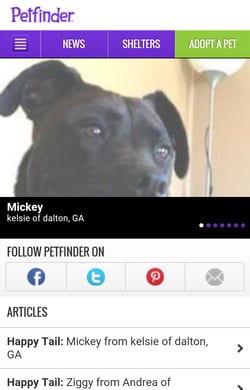
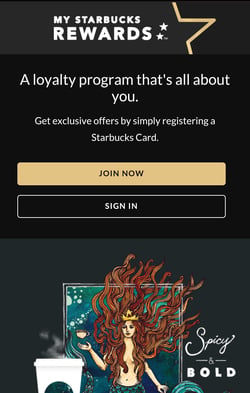
On the left is a popular site for finding potential furry family members. The most important buttons are easy to click (greatly reduced chances of fat-finger clicking). Social sharing buttons are prominently displayed and the text is easy to read. No zooming necessary.
On the right is Starbucks' mobile site. Their CTAs are set apart, the new format is very simple, and it's obvious what actions they want you to take. Their images are eye-catching and distinct.
N
Non-Gated Content - Content that's openly accessible to the public.
O
Organic Search - Non-paid results of a search engine query.
You can improve your organic search rankings with an effective SEO campaign.
Here is an example. Organic results fall in the red box; paid results are indicated by the yellow "Ad" next to the URL, and the "Sponsored" indicator above the Google shopping section.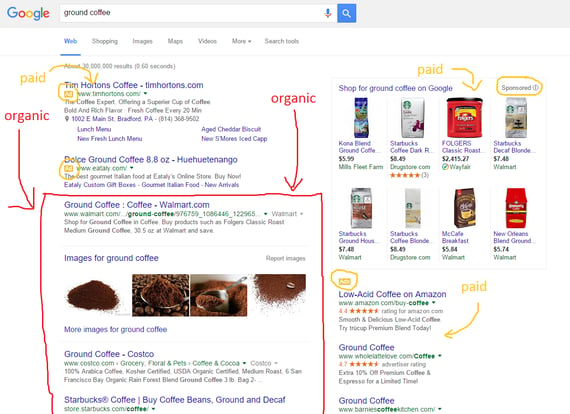
Outbound Marketing (Traditional Marketing) - Interruption marketing. Typically paid advertising. Non-targeted; ads are blasted at as many random people as possible. Kind of like playing blindfolded lawn darts.
Examples: TV ads, radio ads, billboards, cold calling.
P
Pay-per-Click (PPC) - An inbound marketing tactic.
PPC advertising means you pay for a search engine to serve your ad to people who search for related keywords of your choosing. You only pay for clicks, not impressions.
Although PPC is paid advertising, it's considered inbound marketing because of its incredible targeting capabilities.
You can target your audience down to a single dad with two kids in backwoods Michigan who went to school in Florida and ate Cheerios for breakfast. (This is only a slight exaggeration.)
Done right, it's effective instantly, and not as expensive as you might think.
R
Remarketing - A kind of marketing campaign that follows your website visitors once they leave your site.
Sound creepy? It gets better.
If a visitor lands on your page, browses a bit, and then leaves without taking any action, ads for your website will start showing up on other websites.
Kind of like touching a possessed vase and having the spirit follow you around, shrieking about BOGO kayaks at Outdoors Land.
Repurposing - Taking the information from one piece of content and turning it into other content formats.
Example: The results of a survey can be repurposed as a video and a blog post, or the text of an eBook can be turned into a series of blog posts or podcasts.
Responsive Design - Designing your website in a way that its components automatically adjusts to fit any size screen.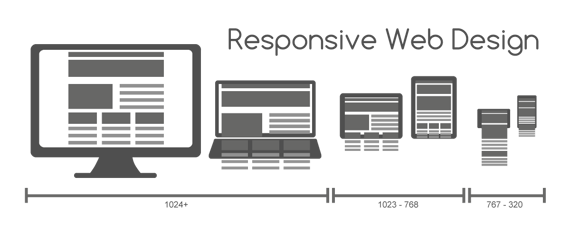
Responsive design goes hand in hand with mobile optimization - it's the easiest and most effective way to optimize your website for mobile devices.
Another option is to create an entirely new mobile site that's separate from your desktop site, but that's as much of a pain in the ass as it sounds.
S
Sales Qualified Lead (SQL) - A lead that has moved passed basic interest and is entering the decision stage of their buyer's journey.
If your marketing and sales teams are separated, the sales team will be the ones handling SQLs.
See the image under the funnel definition for a visual representation.
Segmentation - Separating leads and customers into groups based on demographics, purchasing habits, or placement in the marketing funnel or buyer's journey.
Usually done through a CRM. Helps personalize email campaigns for the appropriate recipients.
Search Engine Optimization (SEO) - An inbound marketing tactic.
SEO is the method of using keywords, visuals, inbound links, etc. to make your website appear higher in organic search engine rankings.
SEO requires an expert understanding of search engines, analytics, and organic search algorithms.
If you're curious about your website's SEO performance, take a look at this SEO checklist and see what you're missing.
Social Media - An inbound marketing tactic.
Social media websites allow users to share content and network with peers.
The most popular social media websites are:
- Facebook - 1.49 billion monthly active users
- YouTube - 1 billion
- LinkedIn - 364 million
- Twitter - 304 million
- Instagram - 300 million
Social media provide an exponential increase in your reach - if one of your customers has 500 friends and shares one of your posts, that's potentially 500 extra views for that piece of content.
Social Media Advertising - An inbound marketing tactic.
Most of the major social media websites have their own unique PPC capabilities. Instead of showing up in search engine results, your social media ads will be served to users on their news feeds.
Social media ads are just as targetable as search ads (sometimes more so). For example, Facebook Ads allows you to list individual job titles for targeting.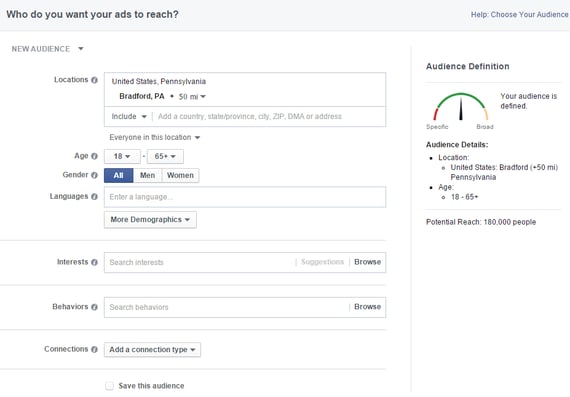
Software as a Service (SaaS) - Software that is centrally hosted and licensed out on a subscription basis.
Instead of installing the software on your company’s machines, you can access it over the Internet from any device.
SaaS is beneficial for businesses who are concerned about bandwidth, hardware management, and difficult software.
T
Thank You Page - Appears after your visitor fills out your landing page form.
The thank you page will show the visitor that their participation is appreciated, and will provide a link to any downloadable content advertised on the landing page.
Traditional Marketing (Outbound Marketing) - Interruption marketing. Typically paid advertising. Non-targeted; ads are blasted at as many random people as possible. Kind of like playing blindfolded lawn darts.
Examples: TV ads, radio ads, billboards, cold calling.
Traffic - The number of people who visit your website AND the pages they click on.
Website traffic is one of our clients' biggest pain points. Traffic is not necessarily their ultimate problem - lack of high-quality traffic is usually a symptom of a larger issue.
Traffic can be measured with all kinds of tools, and is one of the metrics marketers use to track their success.
W
Website Design - An inbound marketing tactic.
Website design is pretty much what it sounds like. It's the process of designing a website, which includes the following elements:
- Navigation
- Structure
- Color scheme
- Interactive elements
- Content
- CTAs and landing pages
- Fonts and styles
- Keyword usage
- Optimization for mobile, search, etc.
- Usability
- And plenty more!
Workflows - Workflows are directly related to marketing automation.
Workflows are the actual commands you enter into your marketing automation software. The commands are a series of "if, then" statements: If the website visitor does X, then Y should happen.
After Y happens, the visitor has a choice of doing Z or A, and the workflow will provide a personalized experience based on the actions that visitor chooses.
Think of it like making your website into a choose your own adventure book.
Thanks for checking out our Comprehensive Inbound Marketing Dictionary!
We hope this resource will help our fellow marketers and businesspeople, newbies and experts alike.
If we forgot important words, left something out of a definition, or are just confused about a word, please leave a comment!
Good Luck and Happy Marketing!

